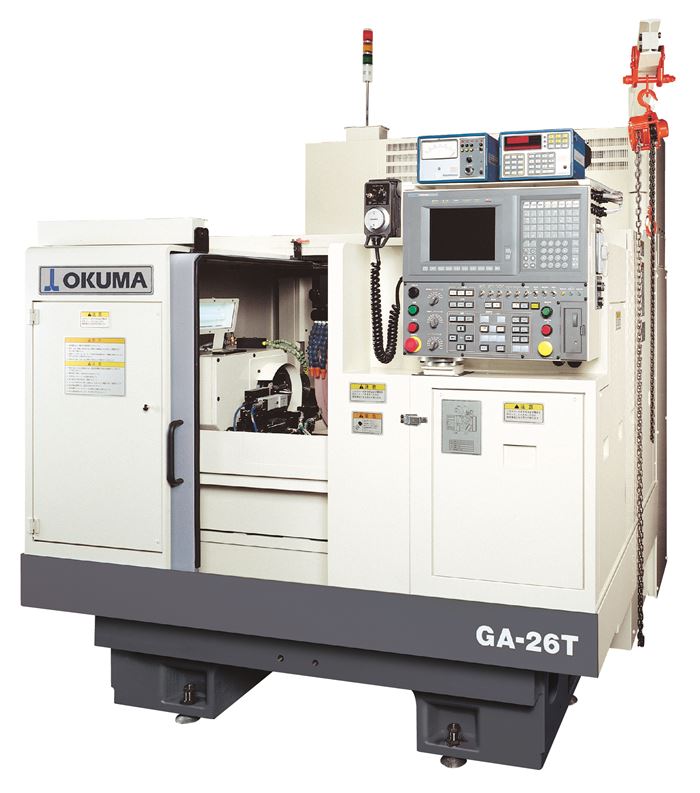Where Grinding Still Beats Hard Turning
For many critical applications, grinding remains the optimal machining process.
Although advances in CNC turning centers and cutting tools have made substantial strides in favor of hard turning over grinding, grinding often turns out to be the better choice. That’s the position taken by Rob Titus, senior applications engineer—grinding products at Okuma America Corp. (Charlotte, North Carolina). Okuma is probably best known for its CNC lathes and machining centers. However, the company also offers a line of cylindrical OD and ID CNC grinders. With these interests in mind, the builder is always eager to find the best process for an application, whether it involves hard turning or grinding.
Mr. Titus points to the GA-26T OD grinder, shown recently at the 2012 International Manufacturing Technology Show (IMTS), as a representative example of grinding technology from Okuma. With automation provided by Gosiger Automation, the CNC grinder is designed for OD finishing of small- to medium-sized parts in high-volume production environments. To make the most of floor space, the grinder holds the workpiece stationary while the grinding wheel traverses back and forth. At the show, this grinder was equipped with in-process gaging, a wheel balancer and a 20-hp wheel spindle.
Mr. Titus frequently advises users on the merits of grinding versus hard turning. He says there are at least seven reasons to grind rather than hard turn:
1. Grinding excels at meeting surface finish, size and roundness requirements. A grinding process can achieve a 6 Ra surface finish, hold a size tolerance of less than 0.0002 inch and grind parts to within 30 millionths roundness.
2. Grinding provides a more cost-effective and stable process than turning for ceramic and carbide material. Hard turning carbides or ceramics requires diamond (PCD or CVD) inserts. Rapid wear and chipping of the inserts can result in size variation or scrapped parts. This adds downtime to change inserts and re-establish part size. In contrast, when grinding these materials with diamond-grit wheels, there is gradual wheel wear. The wheel can be dressed to expose new diamond grains without stopping production.
3. Grinding meets the “no lead” specification. This spec refers to the “spiral” visible on a turned shaft. It is created by a single-point cutting tool moving transversely as the part rotates on a lathe. This surface pattern can cause premature failure of seals on a shaft. By plunge grinding the shaft, the lead is eliminated.
4. Grinding is a common customer requirement. Automotive, aerospace and medical markets often specify a ground finish on critical parts.
5. Grinding wheels are not affected by interrupted cuts created by workpieces with features such as keyways or splines. Depending on the shape and size of these features, the interrupted cut can cause premature insert chipping in hard turning operations.
6. Grinding wheels cost less per part than other types of tooling. In some common cases, a grinding wheel can last 120,000 parts before it needs to be changed. If the cost of the wheel is $600, that’s a half a penny per part.
7. Grinding requires less downtime. How many times will an insert need changing on a CNC lathe throughout 120,000 parts?
Mr. Titus notes that most decisions about grinding or hard turning are not cut and dry. These decisions usually require expertise in both grinding and turning, he says, hence the value of consulting with Okuma, its distributor network or Partners in THINC consortium of technology providers. “We are certainly interested in raising the awareness that Okuma has a range of grinder models, but our primary concern is maximizing the user’s productivity and effectiveness,” he says.
Related Content
Palmgren Launches Combination Bench Lathe, Mill
The 11" bench engine lathe and gear head mill is able to handle a wide range of turning, milling and drilling operations typically found on much larger machinery.
Read MoreChoosing a Five-Axis Machine Tool With Automation in Mind
While much focus is placed on the machinery that moves parts, the features most important for automating five-axis machining are arguably found in the machine tool itself.
Read MoreVolumetric Accuracy Is Key to Machining James Webb Telescope
To meet the extreme tolerance of the telescope’s beryllium mirrors, the manufacturer had to rely on stable horizontal machining centers with a high degree of consistency volumetric accuracy.
Read MoreBuying a Lathe: The Basics
Lathes represent some of the oldest machining technology, but it’s still helpful to remember the basics when considering the purchase of a new turning machine.
Read MoreRead Next
3 Mistakes That Cause CNC Programs to Fail
Despite enhancements to manufacturing technology, there are still issues today that can cause programs to fail. These failures can cause lost time, scrapped parts, damaged machines and even injured operators.
Read MoreThe Cut Scene: The Finer Details of Large-Format Machining
Small details and features can have an outsized impact on large parts, such as Barbco’s collapsible utility drill head.
Read MoreObscure CNC Features That Can Help (or Hurt) You
You cannot begin to take advantage of an available feature if you do not know it exists. Conversely, you will not know how to avoid CNC features that may be detrimental to your process.
Read More




















.png;maxWidth=300;quality=90)







